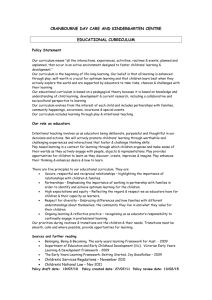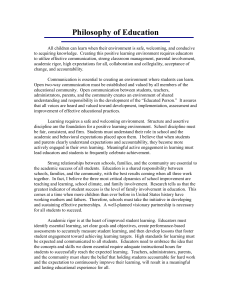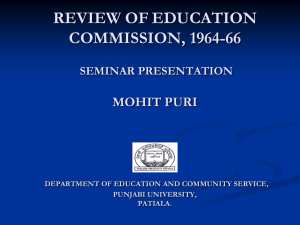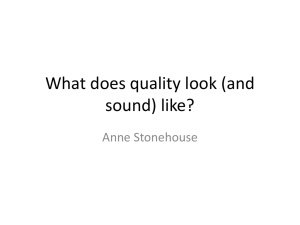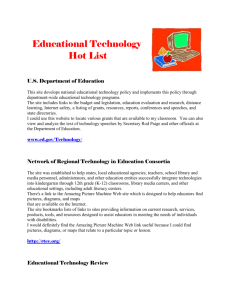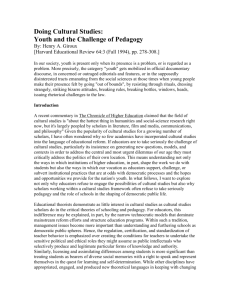Multiculturality & higher education
advertisement
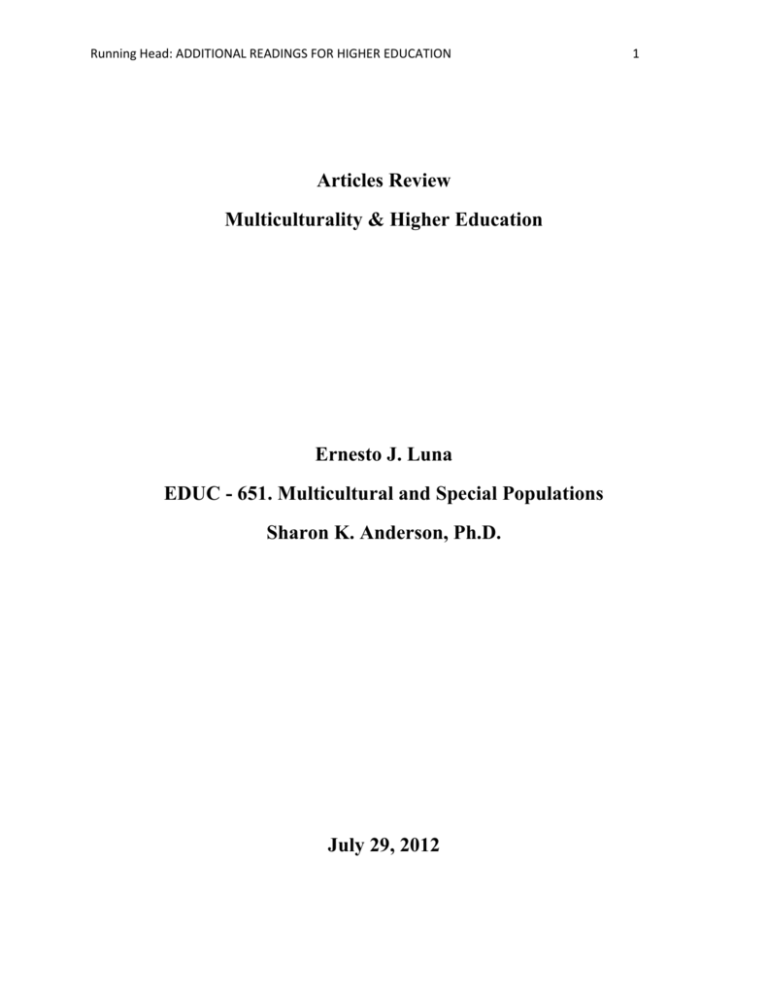
Running Head: ADDITIONAL READINGS FOR HIGHER EDUCATION Articles Review Multiculturality & Higher Education Ernesto J. Luna EDUC - 651. Multicultural and Special Populations Sharon K. Anderson, Ph.D. July 29, 2012 1 2 ADDITIONAL READINGS FOR HIGHER EDUCATION This paper explores different issues in multiculturalism in higher education through the review of five different articles. All articles present approaches for understanding multiculturalism. All five articles are written to help educators understand how postsecondary students try to make sense of multiple identities in institutions that confront them with everchanging understanding of cultural dimensions such as gender, race, and ethnicity. Also discussed in the articles is student-student interaction relative to intersecting identities. Interactant-Based Definitions of Intercultural Interaction at a Multicultural University Halualani, R. T. (2010) This study examines how students in The Multicultural University define and make sense of intercultural interactions. The Multicultural University houses many students from varied cultural backgrounds. This allows researchers to examine the amount and nature of intercultural interaction among culturally different students. The main objective of the research is to answer the question: how do multicultural university students (from varied backgrounds in terms of gender, age, religion, race, sexual orientation, socioeconomic status, nationality, etc.) define and make sense of intercultural interaction in the first place? For that purpose the author analyzes and examines the experience of a diversified sample of students through in-depth interviews. The students’ definitions of culture and inter-culture are shaped by how students (a) delineate which groups are culturally different from them, (b) value and judge individual cultural groups in society, and (c) are in relation to their own positioning in the ethno-racial power hierarchy of the United States. Based on those three aspects, the study finds that the historical and sociopolitical contexts of the interactant nationalities play an important role in how students evaluate an intercultural interaction. Another interesting finding is that the definitions and understanding of intercultural 3 ADDITIONAL READINGS FOR HIGHER EDUCATION interaction change when the cultural background of the person the individual is interacting with changes. Although it might seem a bit generalist at the beginning, the article presents ideas that are supported in other readings analyzed throughout the period. The three aspects clearly identify and explain in a very understandable way how higher education students see multiculturalism and how it depends on different concepts and pre-conceived ideas they might have. It is important to educators to understand these pre-conceived ideas of how intercultural communication and relations could and should be. This appreciation of how students see their peers helps me to understand their behavior toward certain subjects and even towards other students and teachers. This understanding could be the basis to prepare and implement different strategies for dealing with multiculturalism in my classroom. White Educators Facilitating Discussions about Racial Realities Quaye, S. J. (2012) Facilitating discussion about race and racism in a classroom is not an easy task for educators. Different studies show that students tend to respond differently to these discussions when facilitated by members of their own race. The problem is that many white educators have found themselves in a difficult position, when facing these subjects in their classrooms, due to their lack of experience, skills, knowledge and preparedness. The article tries to answer the question: how do educators engage students in constructive discussions about racial realities in postsecondary classroom settings? For that purpose, the author focuses only on exploring the role of white postsecondary educators (with mostly white students) facilitating discussions about race in their courses. 4 ADDITIONAL READINGS FOR HIGHER EDUCATION White educators are uniquely positioned to engage white students in discussions about race due to the predominantly white settings in which they are situated. But at the same time, white educators are the most resistant in implementing specific measures to promote and improve racially inclusive classroom environments. The study focuses on two white educators’ experiences, Corrine and Dalton. Both have experience facilitating racial discussions with white students in their courses. Both agree that in order to engage white students at multiple levels of understanding about racial realities, they rely upon multifaceted practices that addressed learners’ readiness to talk race and racism. It is interesting to see how educators acknowledge and understand how the effectiveness of talks about racism depends in part not only on the students’ race, but also on the race of the educator facilitating the discussion. Although focused on white educators, the article presents a method of talking about race that can be utilized by educators of any race who want to talk not only about racism, but about any other isms. The strategies explored in this article give us ideas on how to manage those topics better. It also provides ideas to give to our colleagues looking for ways to handle this discussion in their own classrooms, even more if they feel detached from the topics themselves. Sidelines and separate spaces: making education anti-racist for students of color Blackwell, D. M. (2010) The way in which anti-racist education is currently conceptualized and practiced holds very few benefits for students of color. The problem is that the reality of anti-racism in the classroom differs from the theory presented to the students. There are pedagogical obstacles that block instructors from positioning students of color as a central educational concern alongside their white classmates. The article argues that anti-racist educators must reexamine their principles and practices from the standpoint of students of color. 5 ADDITIONAL READINGS FOR HIGHER EDUCATION The author uses her own experiences as an African-American graduate student and even includes the black feminist standpoint theory to discuss the importance of racially separate spaces as a pedagogical intervention that can make education anti-racist for students of color. The author also explains how critical educational scholars, in an attempt to challenge the common notions of racism, have merged the concerns of whiteness theory with anti-racist pedagogy to expose not only how whiteness works as a system, but also how white people are participants and benefactors of this system of privilege and oppression. The three approaches presented in the article are straightforward and easy to understand for readers familiarized with the concepts of racism and whiteness. It seems possible for educators to effectively include whiteness into critical pedagogy to challenge the students’ ideas of racism. The approaches became even more understandable through the author’s experiences and observations as a graduate student. It is an interesting reading for both educators and students who are trying to create an inclusive environment to talk and understand racism and whiteness. The approaches explained in this article give us a starting point to do more research on how to incorporate anti-racist pedagogy in the classroom and how students might react to those conversations and methods. Constructivist and Intersectional Interpretations of a Lesbian College Student’s Multiple Social Identities. Abes, E. S. (2012) The process of researching relationships among college students’ multiple social identities is itself a complex phenomenon that reveals numerous ways in which these relationships are conceptualized. Gay students not only are starting to understand their identities in more complex ways, but also face issues with heterosexism and homophobia. 6 ADDITIONAL READINGS FOR HIGHER EDUCATION The use of multiple theoretical perspectives is necessary to understand the multiple contexts in which students’ lives develop. The purpose of this research is to use constructivism (to address power) and intersectionality (to address how multiple power structures shape lived experience) to explore multiple interpretations of relationships among social identities. This study especially challenges educators to embrace multiple, and even contradictory, possibilities about lesbian identity. The study focuses on Gia, a college student who at the time of the study was in college and found herself at a crossroads in her development as an individual trying to make sense of her multiple social identities. Dynamics among Gia’s privileged and marginalized identities played out in contradicting ways as she simultaneously faced privilege and oppression. Due to her sexual orientation, gender and social class, Gia faced marginalization, but felt privilege due to her race. As a result Gia developed transitional meaning-making, an ability necessary to understand how power structures shape relationships among identities while interlocking power structures shape the meaning and nature of development and identity. The results of the study demonstrate that together, constructivism and intersectionality explain aspects of identity that neither framework singularly uncovers. The use of multiple theoretical approaches is a method that deserves further research and could help not only those who want to understand how different identities work in a postsecondary student, but also those who are looking for a method to analyze this interaction among identities. Pedagogy of Inclusion: Integrated Multicultural Instructional Design (Higbee, Schultz & Goff, 2012) 7 ADDITIONAL READINGS FOR HIGHER EDUCATION Recent research in the U.S. shows that participating in a diverse learning environment can enhance the educational experience for all postsecondary students and could help in development of leadership, critical thinking, and cross-cultural communication skills. The article presents integrated multicultural instructional design (IMID), a new pedagogical model that is responsive to the growing student diversity in postsecondary institutions. IMID focuses on teaching but also addresses other supports for learning. In the article the term “student diversity” defines the existence of students’ diverse social identities (race, gender, sexual orientation, social class, etc.), and “multiculturalism” defines how professional educators consider multiple cultural perspectives in responding to these diverse social identities. “The primary goal of IMID is to promote the integration of multicultural content and diverse teaching and learning strategies in postsecondary curricula, programs, courses, and academic support services.” IMID addresses guidelines and strategies for (a) how we learn / teach, (b) what we learn / teach, (c) how we access academic support services / how we support learning, and (d) how we demonstrate what we have learned / how we assess learning. Educators and students can benefit from this approach since it provides strategies to work with an open mind and rules that help break stereotypes and pre-conceived ideas based on the different social identities the students might have. The end result of implementing IMID is the generation of an all-inclusive environment that promotes creativity and the development of skills according to each student’s own diversity. Although it is challenging to implement in one’s practice, the idea of helping the students improve their productivity by focusing on their multiple identities is appealing enough to try it. 8 ADDITIONAL READINGS FOR HIGHER EDUCATION References Abes, E. S. (2012). Constructivist and intersectional interpretations of a lesbian college student’s multiple social identities. The Journal of Higher Education, 83 (2), 186-216. Blackwell, D. M. (2010). Sidelines and separate spaces: making education anti-racist for students of color. Race Ethnicity and Education , 13 (4), 473–494. Goff, E., Higbee, J. L., & Schultz, J. L. (2010) Pedagogy of inclusion: Integrated multicultural instructional design. Journal of College Reading and Learning, 41 (1), 49-66. Halualani, R. T. (2010). Interactant-based definitions of intercultural interaction at a multicultural university. The Howard Journal of Communications, 21(1) 247–272. Quaye, S. J. (2012). White educators facilitating discussions about racial Realities. Equity & Excellence in Education, 45 (1), 100-119.

